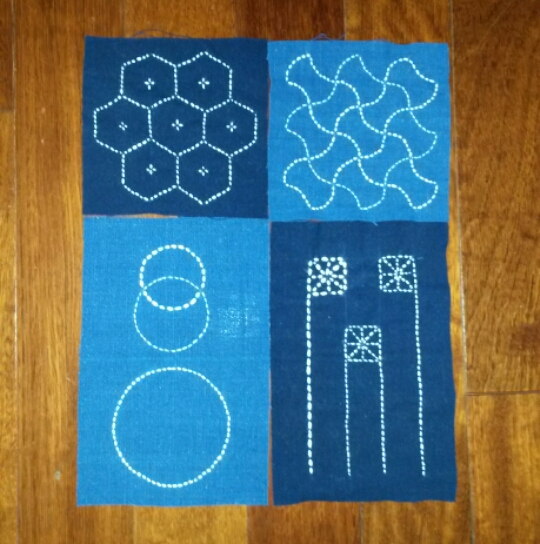It’s not in a quilter’s nature to have only one project going at a time. So last weekend, I went to my very first quilt guild workshop (I figured since I’d been a member for almost 12 years, it was time to finally attend one of the workshops).
The topic was sashiko, a Japanese decorative stitching technique usually done in white thread on indigo fabric. I’ve been interested in it for a long time (it features lots of interlocking geometric patterns, which I find super cool-looking), and when I found out one of the rare Saturday workshops featured this technique, it felt like it was meant to be.
Fun facts I learned in the class:
- Sashiko is pronounced with the emphasis is on the first syllable. I’ve been saying it wrong for years.
- It’s not really a quilting stitch, in that it’s usually just holding two pieces of fabric together with no batting in between the two pieces, and the stitching doesn’t look the same on the back as the front (plus you can see the knots on the back).
- The technique was originally used to patch or reinforce work clothes with scraps of fabric. Apparently cotton was not available to the lower classes in Japan until the 1800’s, but they were able to get their hands on scraps of cotton from the worn-out clothes of the upper class, and sew those patches on to their own hemp clothing to make them sturdier.
- The sashiko thread is much thicker than quilting thread, and is usually doubled up for the stitching. The result: sashiko needles are nearly impossible to thread.
- The fabric is traditionally dyed indigo because the indigo plant has insect repellent properties, making it great for outdoor work clothes. Also, it smells kind of weird (that’s my own observation).
The picture above shows the work I did in class. The bottom two pieces were for practicing making curved lines (left), and making straight lines and turning corners (right). We worked with three different thicknesses of thread (in the flags sampler, the left one is done in the thickest thread, and the middle one uses the thinnest thread).
The top two pieces were actual traditional sashiko designs. On the left is Juji-Kikko (cross in tortoiseshell), and on the right is Fundo (counterweights).
On the counterweights design, I played with using different thicknesses of thread in the design. You can sort of see that the overall design looks like two wavy sticks crossed over a wavy diamond. The sticks were done in medium-weight thread and the diamond in light-weight thread.
This was definitely a fun use of my Saturday, while I wait for the ironing ban to be lifted. T minus 2 days and counting!
